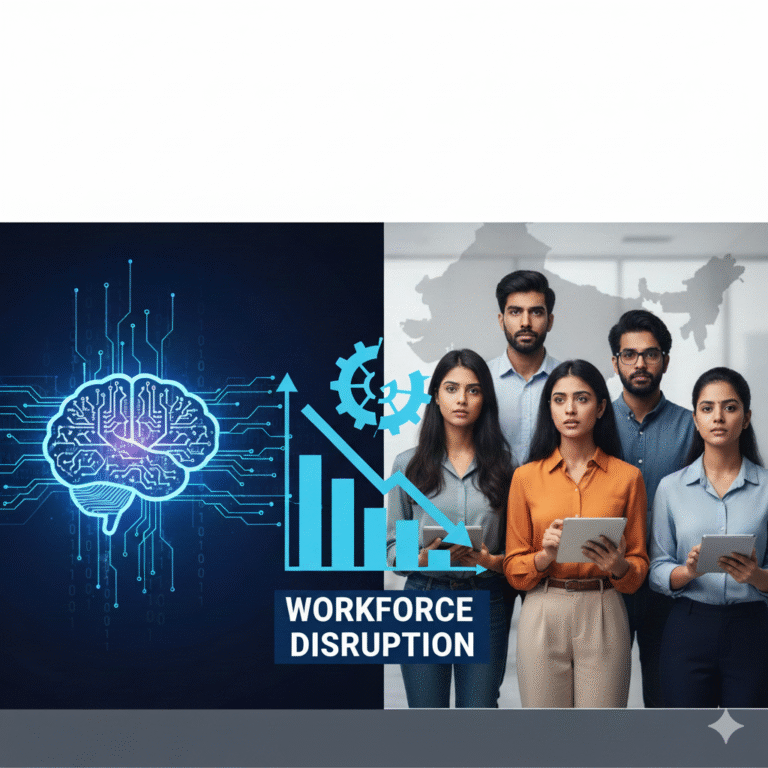Key Highlights
- Revolutionary Recognition: Nobel Economics Prize 2025 awarded to Joel Mokyr, Philippe Aghion, and Peter Howitt for explaining “innovation-driven economic growth” worth 11 million Swedish kronor (~$1.2 million)
- Historical Breakthrough: Mokyr’s research reveals sustained growth only emerged after 1800, requiring specific institutional prerequisites – openness to ideas, knowledge networks, and resistance to change management
- Mathematical Framework: Aghion and Howitt’s 1992 model formalized Schumpeter’s “creative destruction” concept, showing how new innovations replace old ones while driving economic expansion
- India’s Innovation Challenge: Despite ranking 38th in Global Innovation Index 2025, India invests only 0.65% GDP in R&D compared to China’s 2.43%, limiting creative destruction potential
- Policy Blueprint: Laureates’ work provides roadmap for India’s Viksit Bharat 2047 through enabling institutional frameworks, reducing expansion frictions, and managing disruption’s social costs
Understanding the Theory: From Stagnation to Prosperity

The 2025 Nobel Prize in Economic Sciences recognizes three economists who fundamentally transformed our understanding of why some economies grow while others stagnate. Joel Mokyr, Philippe Aghion, and Peter Howitt have provided the intellectual framework for understanding innovation as the primary driver of sustained economic growth – insights directly relevant to India’s ambitious Viksit Bharat 2047 vision. nobelprize
The prize allocation reflects the complementary nature of their contributions: Mokyr receives half the prize for identifying prerequisites for sustained technological progress, while Aghion and Howitt share the other half for their mathematical theory of growth through creative destruction. This recognition comes at a crucial time when India seeks to transition from factor-driven to innovation-driven growth.
Their collective work addresses a fundamental economic puzzle: For most of human history, living standards remained essentially static. Yet since 1800, sustained economic growth has transformed entire societies, lifting millions from poverty and creating unprecedented prosperity. Understanding this transformation provides essential insights for emerging economies like India.
Joel Mokyr: The Historical Detective of Growth
Mokyr’s groundbreaking contribution lies in using historical analysis to identify why sustained growth began so recently in human history. As an economic historian at Northwestern University, he uncovered the specific conditions that enabled the transition from millennia of stagnation to continuous progress.
The Great Divergence occurred around 1800 when certain societies, particularly Britain, created environments where scientific discoveries and practical applications began feeding each other in self-reinforcing cycles. Before this period, innovations occurred sporadically but failed to generate sustained progress because ideas didn’t build upon one another systematically.
Mokyr identified three crucial prerequisites for sustained growth:
Openness to New Ideas: Societies must welcome innovation and resist the temptation to suppress disruptive technologies that threaten established interests. This openness requires institutional frameworks protecting innovators and preventing entrenched powers from blocking progress.
Knowledge Networks: Critical connections between theoretical scientists and practical inventors enable discoveries to translate into applications. The Industrial Revolution succeeded because Britain developed robust networks linking universities, workshops, and commercial enterprises.
Managing Resistance to Change: Every innovation creates winners and losers. Sustained growth requires institutions that manage this disruption without allowing resistance to halt progress entirely.
Contemporary relevance extends to modern challenges. Mokyr suggests that technologies like artificial intelligence are strengthening the science-application feedback loop, potentially accelerating innovation globally. However, he warns that progress isn’t automatic – it requires active protection through appropriate policies addressing pollution, climate change, inequality, and other challenges that could derail the growth machine.
Aghion and Howitt: Mathematizing Creative Destruction

Philippe Aghion and Peter Howitt’s 1992 breakthrough provided the mathematical framework that formalized Joseph Schumpeter’s concept of “creative destruction”. Their model explains precisely how innovation drives economic growth while simultaneously creating and destroying value across the economy. macrohive
The core insight of creative destruction lies in recognizing that economic progress requires not just creation of new products and processes, but also the destruction of outdated ones. When smartphones emerged, they didn’t merely add to existing communication options – they systematically displaced landline phones, public call offices (PCOs), and entire industries built around older technologies.
Their mathematical model demonstrates how this process works:
Innovation Incentives: Entrepreneurs invest in research and development because successful innovations generate temporary monopoly profits. These profits provide the financial returns necessary to justify risky investments in uncertain technologies.
Competitive Dynamics: New innovations eventually face competition from even newer technologies, eroding monopoly positions and forcing continuous innovation cycles. This competition prevents any single firm from maintaining permanent dominance while ensuring ongoing technological progress.
Resource Reallocation: Creative destruction forces resources – capital, labor, and materials – to flow from declining sectors to expanding ones. This reallocation improves overall economic efficiency while generating aggregate growth.
The policy implications are profound. Their framework suggests that optimal economic policy must balance protecting innovation incentives through patent systems with maintaining competitive pressure that prevents excessive market concentration.
The India Challenge: Why Creative Destruction Remains Low
India’s economic transformation presents a fascinating case study for applying the Nobel laureates’ insights. Despite being the world’s third-largest startup ecosystem with over 100,000 government-recognized startups and 100+ unicorns, India faces fundamental challenges in generating the creative destruction necessary for sustained innovation-driven growth.
Research specifically focused on India reveals troubling patterns. The country has a disproportionately high share of small firms compared to developed economies, yet aggregate exit rates remain similar to countries like the United States. This combination suggests that Indian firms exit at similar rates despite being much smaller, indicating low creative destruction intensity.
The Subsistence Entrepreneurship Problem
A critical insight from recent research suggests that many Indian enterprises represent “subsistence entrepreneurship” rather than transformative innovation. These businesses emerge from necessity – the absence of stable employment alternatives – rather than from opportunities to create and scale innovative solutions.
Three hypotheses explain India’s low creative destruction:
High Expansion Costs: Existing firms face significant barriers to scaling operations, preventing them from growing large enough to displace inefficient competitors. These frictions include regulatory compliance burdens, labor market restrictions, and infrastructure bottlenecks.
Subsistence Dominance: When the majority of firms are run by necessity entrepreneurs rather than opportunity entrepreneurs, creative destruction naturally remains low. There are simply too few transformative firms with growth potential to affect meaningful resource reallocation.
Circular Causality: Low creative destruction both causes and results from underdevelopment. Without sufficient competitive pressure, resources don’t reallocate to productive firms. But without productive firms, competitive pressure can’t emerge. egc.yale
India’s Innovation Ecosystem: Progress and Gaps

India has made remarkable strides in building innovation infrastructure. The country now ranks 38th in the Global Innovation Index 2025, leading all lower-middle-income economies. Patent applications have grown dramatically, with India now ranking 6th globally, and the patent-to-GDP ratio improving from 144 in 2013 to 381 in 2023.
Government initiatives demonstrate serious commitment to innovation-driven growth:
Financial Support: The Fund of Funds for Startups maintains a ₹10,000 crore corpus, while the new ₹1 lakh crore Research, Development, and Innovation (RDI) scheme targets private sector R&D.
Institutional Infrastructure: The Startup India Hub connects over 1,140 incubators and accelerators, with the Startup India Seed Fund Scheme providing ₹945 crore for seed funding in 2023.
Strategic Sectors: Major investments include the National Semiconductor Mission (₹76,000 crore), IndiaAI Mission, and PLI schemes for quantum technologies.
Geographic Democratization: Over 45% of DPIIT-recognized startups now emerge from tier-2 and tier-3 cities, indicating innovation’s spread beyond traditional metros. pib.gov
The R&D Investment Gap
Despite progress, India’s R&D investment remains critically insufficient for innovation-driven growth. At 0.65% of GDP, India lags significantly behind China (2.43%), Brazil (1.15%), and South Korea (2.5%). The Nobel laureates’ work suggests this investment gap directly limits creative destruction potential.
For Viksit Bharat 2047, reaching at least 2% GDP investment in R&D appears essential – a target that would require more than tripling current spending. This expansion must focus particularly on private sector R&D, which generates the market-driven innovation that powers creative destruction.
Policy Lessons for India
Building Institutional Prerequisites (Mokyr’s Framework)
India must systematically build the institutional environment that enables sustained innovation:
Protecting Academic Freedom: Universities and research institutions require autonomy to pursue basic research without political interference. The proposed Anusandhan National Research Foundation represents progress, but implementation must prioritize intellectual independence.
Strengthening Knowledge Networks: Enhanced connections between universities, research institutions, and industry can accelerate technology transfer. Successful models like BIRAC (Biotechnology Industry Research Assistance Council) should be replicated across other technology sectors.
Managing Social Disruption: Innovation inevitably displaces workers and disrupts communities. India needs robust social safety nets, reskilling programs, and transition assistance to manage creative destruction’s human costs while maintaining political support for continued innovation.
Enabling Creative Destruction (Aghion-Howitt Insights)
Policy must address the specific frictions that limit creative destruction in India:
Reducing Expansion Costs: Regulatory reforms should focus on enabling existing growth-oriented firms to scale efficiently. This includes streamlining compliance requirements, improving labor market flexibility, and reducing infrastructure bottlenecks.
Facilitating Efficient Exit: The Insolvency and Bankruptcy Code represents progress, but implementation must enable genuinely unproductive firms to exit while protecting workers and creditors. Efficient exit mechanisms are essential for resource reallocation.
Competition Policy: Preventing excessive market concentration while allowing successful firms to grow requires sophisticated antitrust enforcement. India’s approach must balance scale economies with competitive dynamism.
Patent and IP Reform: Optimal intellectual property protection incentivizes innovation while ensuring knowledge spillovers. The laureates’ work suggests a “patent Laffer curve” where both excessive and insufficient protection harm growth.
Sectoral Applications: From Theory to Practice
Digital Economy and AI
The laureates’ framework provides crucial guidance for India’s AI and digital economy strategy. Mokyr’s insight that AI could strengthen science-application feedback loops suggests enormous potential for innovation acceleration. However, realizing this potential requires institutional frameworks that manage AI’s disruptive impacts.
India’s Digital Public Infrastructure (DPI) – including UPI, Aadhaar, and related systems – demonstrates successful innovation ecosystem building. These platforms enable creative destruction by reducing transaction costs and enabling new business models while providing the institutional stability necessary for sustained growth.
Manufacturing and Make in India
Creative destruction insights challenge traditional manufacturing policy approaches. Rather than protecting existing firms through subsidies, policy should focus on enabling competitive dynamics that force efficiency improvements while supporting displaced workers through transition assistance.
The Production Linked Incentive (PLI) schemes show promise but require careful design to avoid protecting inefficient producers. Success depends on maintaining competitive pressure while providing temporary support for capability building.
Sustainable Development Integration
The Nobel laureates emphasize that innovation must address environmental challenges rather than ignore them. India’s green technology push through initiatives like the National Solar Mission and electric vehicle promotion demonstrates appropriate integration of innovation policy with sustainability goals.
However, avoiding the “grow now, clean later” trap requires ensuring that environmental considerations are built into innovation incentives from the beginning rather than retrofitted later.
Governance and Development Theory
The 2025 Nobel Prize provides essential insights into the relationship between institutions, innovation, and growth. The laureates’ work demonstrates that economic development is not automatic or inevitable – it requires specific institutional conditions and policy choices.
Key governance lessons include:
Institutional Design Matters: The quality of institutions determines whether innovation translates into sustained growth or remains sporadic. Democratic institutions can provide the openness and adaptability necessary for innovation, but only if designed appropriately.
Policy Sequencing: Successful innovation policy requires careful sequencing – building institutional capacity before scaling interventions, developing competitive markets before innovation subsidies, and creating social safety nets before enabling creative destruction.
Measurement and Evaluation: Traditional GDP-focused metrics miss the qualitative improvements that drive real welfare gains. Policy must track innovation outcomes, not just innovation inputs.
Contemporary Challenges and Future Directions
The laureates’ work gains particular relevance as India faces the challenge of transitioning from factor-driven to innovation-driven growth. Several contemporary developments require careful analysis through their theoretical lens:
Artificial Intelligence: As AI transforms industries globally, India must position itself as a creator rather than merely a consumer of AI technologies. This requires investments in basic research, talent development, and institutional frameworks that enable AI innovation while managing its disruptive impacts.
Climate Technology: The transition to sustainable development creates enormous innovation opportunities. India’s success in solar energy cost reduction demonstrates the potential for combining innovation policy with environmental goals.
Global Value Chains: Creative destruction operates globally, not just nationally. India’s integration into global innovation networks requires balancing openness to foreign technology with building domestic innovation capabilities.
Measuring Success: Beyond GDP to Innovation Outcomes
The Nobel laureates’ emphasis on qualitative improvements challenges traditional development metrics. For Viksit Bharat 2047, success indicators must include:
Innovation Intensity: Metrics beyond R&D spending, including patent quality, technology transfer rates, and startup survival rates adjusted for growth potential.
Creative Destruction Indicators: Measures of firm turnover, resource reallocation efficiency, and the balance between job creation and destruction across sectors.
Institutional Quality: Assessments of regulatory quality, academic freedom, intellectual property protection, and social safety net effectiveness.
International Comparisons and Learning
The laureates’ work enables sophisticated comparison between different development models:
China vs. India: Both countries pursue innovation-driven growth but through different institutional approaches. China’s state-directed model versus India’s market-based approach offers natural experiments in applying the laureates’ insights.
East Asian Tigers: Countries like South Korea and Taiwan successfully transitioned to innovation-driven growth through heavy R&D investment and institutional development – pathways relevant to India’s trajectory.
European Models: The laureates specifically urge Europe to learn from U.S. and Chinese success in combining competition with industrial policy – lessons equally relevant for India.
Risk Management: When the Growth Machine Stops
The Nobel laureates warn that progress is fragile and can reverse. Five specific threats to India’s innovation-driven growth require constant vigilance:
Market Concentration: Excessive concentration in key sectors could stifle innovation. India’s approach to regulating large technology platforms will test its ability to balance scale advantages with competitive dynamics.
Research Restrictions: Political interference in academic research or restrictions on international collaboration could undermine the knowledge networks essential for innovation.
Knowledge Localization: Excessive restrictions on technology transfer or data flows could isolate India from global innovation networks.
Resistance to Change: Growing inequality or regional disparities could generate political backlash against innovation if not managed through appropriate social policies.
Institutional Decay: Corruption, regulatory capture, or politicization of institutions could undermine the foundations necessary for sustained innovation.
The Path to Viksit Bharat 2047
The 2025 Nobel Prize in Economics provides both inspiration and practical guidance for India’s development journey. The laureates’ insights demonstrate that sustained, innovation-driven growth is achievable but requires deliberate policy choices and institutional development.
India’s demographic dividend, technological capabilities, and democratic institutions provide unique advantages for becoming an innovation-driven economy. However, realizing this potential demands learning from the laureates’ key insights: innovation drives prosperity only when societies remain open to ideas, competition, and change.
The transformation from today’s India to Viksit Bharat 2047 requires mastering creative destruction – enabling the continuous process of innovation, competition, and resource reallocation that drives sustained growth while managing its social and political consequences through appropriate institutional frameworks.
Success depends not on avoiding disruption, but on building the institutional capacity to harness disruption for broad-based prosperity. The Nobel laureates have provided the roadmap; India must now demonstrate the political will and institutional capability to follow it.









+ There are no comments
Add yours